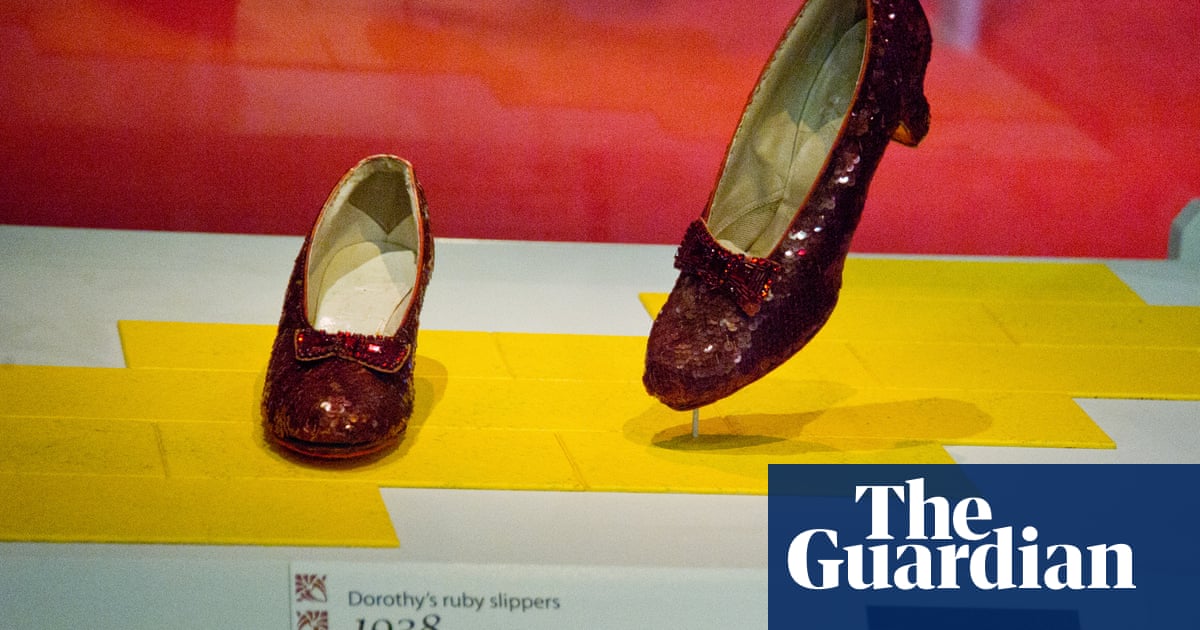
At his sentencing hearing on Monday, a terminally ill thief who admitted to stealing a pair of ruby slippers worn by Judy Garland in The Wizard of Oz in an attempt to make a final big score, was not given a prison sentence.
In 2005, Terry Jon Martin, 76, took the slippers from the Judy Garland Museum in Grand Rapids, Minnesota, her hometown. His lawyer shared in a memo to the federal court in Duluth that Martin succumbed to the temptation after being told by a former mob associate that the shoes had to be decorated with genuine jewels in order to legitimize their insured value of $1 million.
Martin remained stoic as the judge delivered the sentence and was unable to stand when the judge ended the hearing.
In 2018, the FBI retrieved the shoes after another individual attempted to claim a reward. It wasn’t until last year that Martin faced charges for stealing them.
In October, he confessed to stealing an important piece of artwork and admitted to breaking the museum’s door and display case with a hammer to take the slippers. However, his reasoning was unclear until his defense lawyer, Dane DeKrey, disclosed it earlier this month.
During the October hearing, Martin, a resident of Grand Rapids, stated that he intended to extract what he believed were authentic rubies from the shoes and sell them. However, he was informed by a fence, someone who trades in stolen items, that the rubies were actually sequins and glass beads. As a result, Martin disposed of the slippers.
According to DeKrey’s memo, Martin’s former associate from the mob convinced him to steal the slippers as a final heist, despite Martin appearing to have moved on from his past troubles after being released from prison 10 years ago.
Initially, Terry rejected the offer to take part in the robbery. However, old patterns are difficult to break, and the idea of a big payoff consumed his thoughts. After careful consideration, Terry gave in to his criminal tendencies and agreed to join in on the heist.
The two parties suggested that judge Patrick Schiltz sentence Martin to the amount of time he has already served, as he is currently confined to his home receiving hospice care and is not expected to live longer than six months. He suffers from chronic obstructive pulmonary disorder and relies on constant oxygen therapy, and was in a wheelchair when he entered his guilty plea.
The usual federal sentencing guidelines suggest a term of approximately four and a half to six years. According to another legal document, both parties have reached a consensus that he should pay $23,500 in restitution to the museum, despite his apparent lack of funds.
DeKrey stated that Martin was unaware of the cultural importance of the ruby slippers and had not watched The Wizard of Oz. DeKrey explained that the “old Terry,” who had a criminal past and was involved in theft and receiving stolen goods, triumphed over the “new Terry,” who had reformed and become a productive member of society since his release from jail in 1996.
The fence informed Martin that the rubies were not genuine. DeKrey reported that he then gifted the slippers to his former mob acquaintance and declared he never wished to encounter them again. According to the lawyer, Martin never received any further communication from the individual. Martin has declined to disclose any other individuals involved in the robbery, and no one else has been prosecuted for the incident.
The method used by the FBI to locate the slippers has not been revealed. In 2017, a man approached the insurer with the promise of recovering the slippers, but he requested a higher amount than the $200,000 reward. The slippers were eventually recovered in Minneapolis during an FBI sting in the following year.
According to federal prosecutors, the estimated market value of the slippers is approximately $3.5 million.
In the well-known 1939 musical, the character played by Garland, Dorothy, needed to tap her ruby slippers three times and say, “There’s no place like home,” in order to go back to Kansas from Oz. She used multiple pairs of slippers during the production, but only four original pairs are still in existence.
Michael Shaw, a collector of Hollywood artifacts, had previously loaned a pair to the museum until Martin took them without permission. The remaining three pairs are currently in possession of the Academy of Motion Picture Arts and Sciences, the Smithsonian Museum of American History, and a private collector.
Per John Kelsh, the initial director of the Judy Garland Museum, the collector has retrieved the slippers and they are currently in the possession of an auction house for safekeeping. The auction house intends to sell them following a promotional tour, and Kelsh expressed skepticism that they will ever be returned to Grand Rapids.
Frances Gumm, later known as Garland, was born in 1922. She resided in Grand Rapids, located approximately 200 miles (320km) north of Minneapolis, until the age of four. Her family then relocated to Los Angeles. She passed away in 1969.
The museum dedicated to Judy Garland, situated in her former residence, claims to possess the biggest assortment of Garland and Wizard of Oz artifacts in the world.
Source: theguardian.com

















